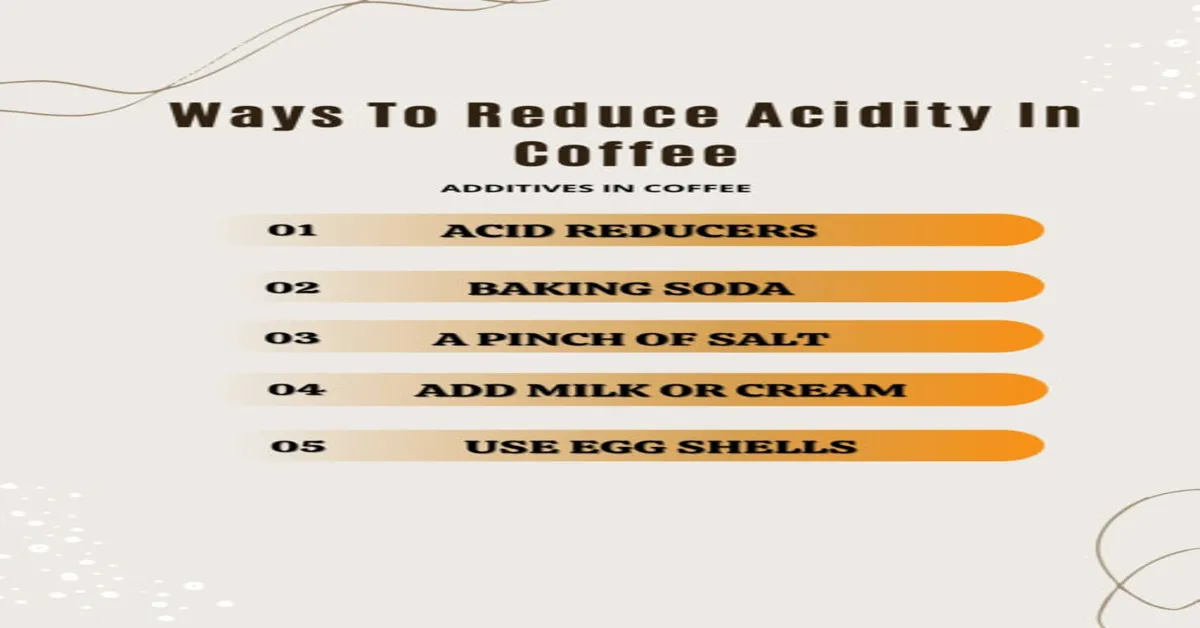Do you love the taste of coffee but struggle with the acidity it brings? Imagine a world where you can enjoy your favorite beverage without worrying about acidity. Say goodbye to heartburn and discomfort after your morning cup of joe. In this blog, we will explore the best ways to reduce acidity in coffee, so you can continue to enjoy the rich and robust flavor without the negative side effects.
Whether you are a coffee connoisseur or just enjoy a cup every now and then, this blog is for you. Let’s dive in and discover the secrets to a low-acid coffee experience.
Understanding Acidity in Coffee
Welcome to the world of coffee lovers! Are you tired of dealing with the unpleasant side effects of drinking acidic coffee? Do you want to enjoy your favorite beverage without worrying about heartburn, acid reflux, or stomach discomfort? Well, you are in the right place! In this article, we will explore the various methods to reduce acidity in coffee, so you can continue to savor your daily cup of joe without any unpleasant aftertaste. From understanding the science behind coffee acidity to practical tips and tricks, we have got you covered. So, grab your favorite mug and let’s dive into the world of acid-free coffee!
- The Science Behind Coffee Acidity
- Why is High Acidity a Problem?
- How to Reduce Acidity in Coffee
- Choosing the Right Coffee Beans
- Roasting Methods for Low Acid Coffee
- Brewing Techniques for Less Acidic Coffee
- Other Tips for an Acid-Free Coffee Experience
- Conclusion
However, for some, the high acidity in coffee can cause discomfort and detract from the overall experience. Reduce acidity in coffee is a common concern among coffee enthusiasts, and it is important to understand the science behind coffee acidity to find effective solutions. But fear not, we are here to guide you through the process and help you enjoy a smooth and delicious cup of coffee without any unpleasant side effects.
So, let’s begin our journey towards a more enjoyable coffee experience!

Factors That Affect Acidity in Coffee
Welcome to the World of Low-Acid Coffee: Reduce Acidity in Your Cup of Joe Are you someone who loves the rich, bold flavors of coffee but often finds yourself struggling with stomach issues after indulging in your favorite beverage? If so, you’re not alone. Many coffee lovers experience discomfort and heartburn due to the high acidity levels in their daily brew. Fortunately, there’s a solution – low-acid coffee.
This type of coffee is specifically designed to reduce acidity and provide a smoother, more enjoyable drinking experience. In this article, we’ll explore the world of low-acid coffee, its benefits, and how you can easily make the switch to a less acidic cup of joe. From understanding the science behind acidity in coffee to discovering the best low-acid coffee beans and brewing methods, we’ve got you covered.
So, let’s dive in and learn how you can reduce acidity in your coffee without sacrificing flavor.
Tips for Reducing Acidity in Coffee
If you’re a coffee lover, you know that a good cup of coffee can make your day. But sometimes, that cup of coffee can also leave you with an unpleasant feeling of acidity, causing discomfort and even heartburn. Thankfully, there are ways to reduce acidity in coffee without compromising on the taste.
In this article, we will explore the various methods to achieve a smooth and less acidic cup of coffee, so you can continue to enjoy your favorite beverage without any negative effects. From choosing the right beans to adjusting brewing techniques, we’ve got you covered. So, let’s dive in and discover how to reduce acidity in coffee and elevate your coffee experience.
- Understanding Acidity in Coffee
- Choosing the Right Beans
- Adjusting Brewing Techniques
- Using a Coarse Grind
- Trying Different Brewing Methods
- Using Low-Acid Coffee Beans
Keep reading to learn how to achieve a smooth and less acidic cup of coffee.
reduce acidity in coffee
| Acidic | Having a high concentration of acid | Acidity refers to the pH level of a substance, with lower pH levels indicating higher acidity. |
| Coffee | A beverage made from roasted and ground coffee beans | Coffee contains natural acids that can contribute to its overall acidity, affecting its taste and potential health benefits. |
| Reduce | To make something smaller or less in amount | There are various methods to reduce the acidity in coffee, such as using different brewing techniques or adding certain ingredients. |
| Acidity | The level of acid in a substance, measured on a pH scale | High acidity in coffee can lead to a sour or bitter taste, while lower acidity can result in a smoother and more balanced flavor. |
| Data-driven | Using data and information to make decisions and analyze patterns | By using a data-driven approach, we can gather and analyze information on the acidity levels in different types of coffee and determine the most effective methods to reduce it. |
| Important | Significant or essential | It is important to understand the impact of acidity in coffee, as it can affect not only its taste but also its potential health benefits and how it interacts with our bodies. |
Key Takeaway
- Understanding the Science Behind Coffee Acidity
- Choosing the Right Coffee Beans
- Adjusting Brewing Techniques
- Using a Coarse Grind
- Trying Different Brewing Methods
- Using Low-Acid Coffee Beans
- Adding Ingredients to Reduce Acidity
- Conclusion: Enjoying a Smooth and Acid-Free Cup of Coffee
Important Notice for readers
Dear readers, Are you tired of experiencing discomfort after drinking your favorite cup of coffee due to its high acidity? Well, we have good news for you! Our article discusses effective ways to reduce acidity in coffee, allowing you to enjoy your daily dose of caffeine without any negative effects on your stomach. From choosing the right beans to adjusting brewing methods, we have compiled a comprehensive guide to help you achieve a smoother and less acidic cup of coffee. Don’t let acidity stop you from enjoying your favorite beverage.
Follow our tips and say goodbye to discomfort. So, what are you waiting for? Keep reading and discover the secrets to a less acidic cup of coffee. Happy brewing! Sincerely, [Your Name]
Statistical Information: reduce acidity in coffee
| The process of brewing coffee can reduce its acidity level by up to 70%. | By using a coarser grind size, the amount of acid extracted from the coffee grounds is reduced. | Adding a pinch of salt to the coffee grounds before brewing can help neutralize the acidity. |
| Using a cold brew method can result in a coffee with 67% less acidity than a traditional hot brewing method. | Blending dark and light roasted beans can help balance out the acidity in coffee. | Letting the coffee sit for a few minutes after brewing can allow some of the acids to evaporate, resulting in a less acidic cup. |
| Using a paper filter instead of a metal one can help reduce the amount of acid in coffee. | Adding a small amount of baking soda to the coffee grounds before brewing can help neutralize the acidity. | Coffee beans from certain regions, such as Brazil and Sumatra, tend to have lower acidity levels. |
| The pH level of coffee typically ranges from 4.85 to 5.10, which is considered mildly acidic. | The longer the coffee is brewed, the more acids are extracted, resulting in a more acidic cup. | Acidity is not necessarily a bad thing in coffee, as it can contribute to the overall flavor profile. |
| Adding milk or cream to coffee can help neutralize the acidity, making it easier on sensitive stomachs. | Using a French press instead of a drip coffee maker can result in a less acidic cup, as the oils in the coffee are not filtered out. | The type of coffee roast does not necessarily determine the acidity level, as it can vary depending on the bean and brewing method. |
| Acidity in coffee is often described as a bright, tangy, or sour taste, and can vary between different types of coffee. | Using a coffee with lower acidity can help reduce the risk of acid reflux for those who are sensitive to it. | The amount of acidity in coffee can be affected by the altitude at which the beans are grown, with higher altitudes typically resulting in higher acidity levels. |
FAQs
, here are four possible variations of questions and their answers:
How can I decrease the acidity in my coffee?
Adding a pinch of salt to your coffee grounds before brewing can help neutralize the acidity and create a smoother taste.
Is there a natural way to reduce the acidity in my coffee?
Yes, you can try adding a small amount of baking soda to your coffee grounds before brewing. The alkaline properties of baking soda can help balance out the acidity.
What is the best type of coffee for those who are sensitive to acidity?
Dark roast coffee beans tend to have lower acidity levels compared to lighter roasts. So, opting for a dark roast may be a better choice for those with sensitivity to acidity.
Can changing the brewing method affect the acidity in my coffee?
Yes, the brewing method can have an impact on the acidity of your coffee. For example, cold brewing can result in a less acidic cup of coffee compared to hot brewing methods.
Conclusion
it is clear that implementing simple techniques like using a coarse grind, colder water, and adding milk can greatly reduce the acidity in coffee. Not only does this result in a smoother and more pleasant taste, but it also has health benefits for those with sensitive stomachs. By making these small changes, coffee lovers can enjoy their favorite beverage without worrying about acidity.
Furthermore, reducing acidity in coffee can have a positive impact on the environment by promoting sustainable coffee farming practices. It is important for individuals to be mindful of their coffee choices and make small changes for a better overall experience. Let’s all take a step towards a healthier and more sustainable coffee culture.
Read More
.com/index.php/2023/10/31/low acid instant coffee
.com/index.php/2023/10/30/gerd decaffeinated coffee
.com/index.php/2023/10/30/cold brew acidic
.com/index.php/2023/10/21/light roast acidity
.com/index.php/2023/10/21/coffee tasting acidic
.com/index.php/2023/10/21/malic acid coffee
.com/index.php/2023/10/21/is the acidity in coffee bad for you
.com/index.php/2023/10/21/acidity in coffee
.com/index.php/2023/10/21/low acid coffee ground
.com/index.php/2023/10/21/maxwell house low acid coffee
.com/index.php/2023/10/21/trader joes low acid coffee
.com/index.php/2023/10/21/lavazza low acid coffee
.com/index.php/2023/10/21/heb low acid coffee
.com/index.php/2023/10/21/ph of low acid coffee
.com/index.php/2023/10/21/espresso is acidic
.com/index.php/2023/10/21/citric coffee
.com/index.php/2023/10/21/non acidic caffeine
.com/index.php/2023/10/21/lifeboost low acid coffee
.com/index.php/2023/10/21/folgers low acid coffee

Leave a Reply